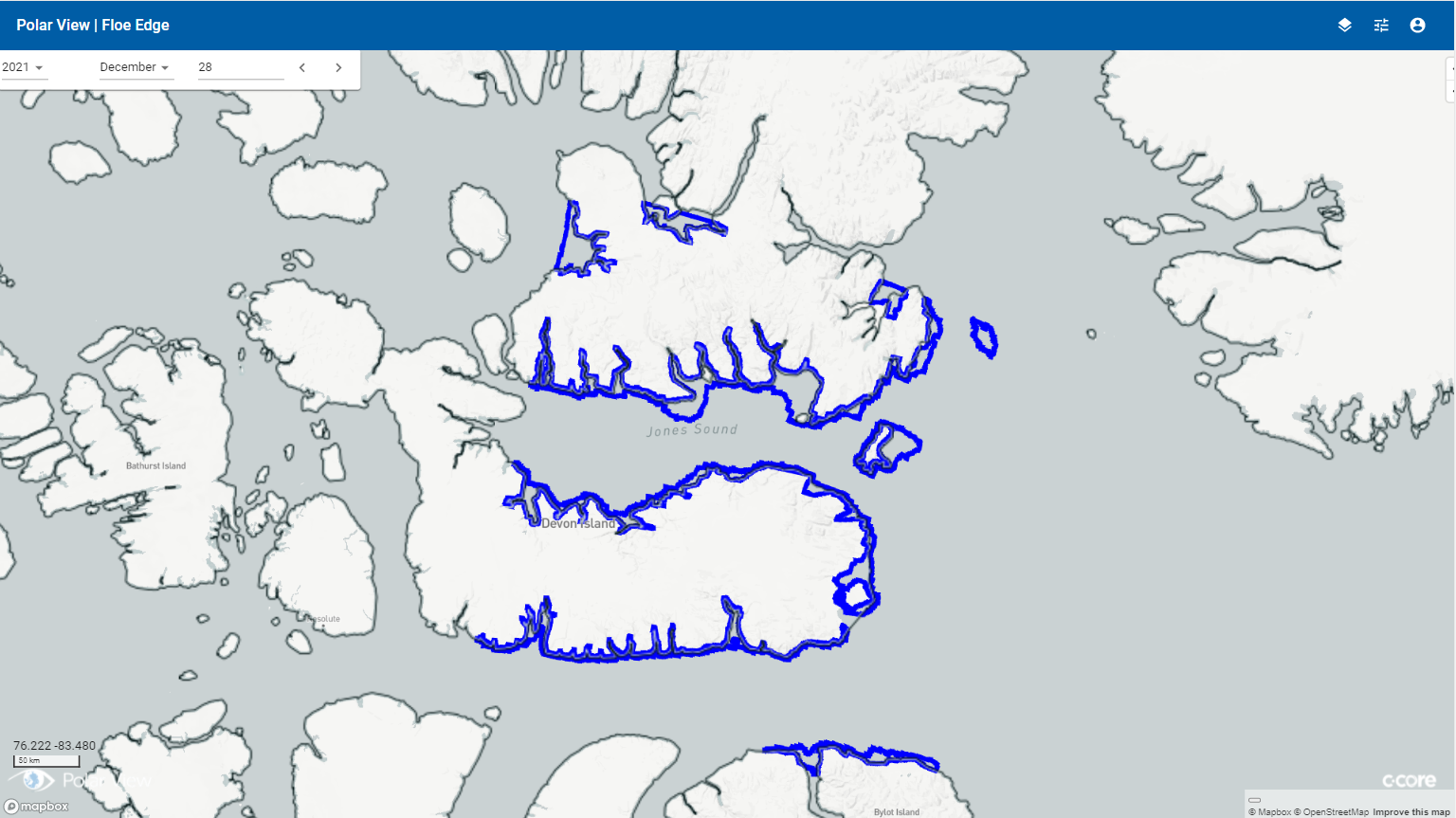Floe Edge
The floe edge products delineate the location of the floe edge near communities in the Canadian Arctic
File Provider (EO Team)#
Product Description#
| Service Name | Description | Data Owners | File Type |
|---|---|---|---|
| Floe Edge | Delineate the location of the floe edge near communities in the Canadian Arctic | John Bennett | geosjon |
Ancilliary Information#
- Product set-up prerequisites:
- AOI
- Time window
- Scihub location
- Sentinel-1 InSAR pair
- Coresight AWS s3 location
Naming Convention#
The following naming convention applies to all floe edge polygon files sent to Coresight:
YYYYMMDDTYYYYMMDDThhss_ID_pm_vel_floe_edge.geojsonYYYY – YearMM – MonthDD – DayDT – Delta Timehh – Hoursmm – MinutesID – Unique ID
Example:
20210825T131601DT2353_059133_pm_vel_floe_edge.geojsonSymbology Map#
Blue lines indicate the location of the floe egde
| Label | Color |
|---|---|
| Floe edge location | #022dba |
File Uploading Instructions#
- All files should be uploaded to Coresight’s Amazon S3 Bucket:
- Fill out the Coresight Product Onboarding Checklist for new products.
Coresight#
Developers#
- Jeremy Hetzel
Processing#
Description#
Data processing takes place locally on C-CORE servers, the products of the processing are uploaded to the cloud. Once the products are on the cloud metadata products are created and added to a STAC catalog to make the products accessible to the online web service.

Ingester Functions#
File receiving: The GRD data is acquired from Copernicus Open Access Hub (Scihub) which is queried daily for revisit pairs covering areas of interest.
Initial storage: The Floe Edge polygons generated from the GRD data by the Floe Edge processing chain are uploaded to an AWS S3 bucket.
File conversions: Once the Floe Edge polygons make it to the AWS S3 bucket, the ice-drift-ingester generates MapBox Vector tiles to be served to the Floe Edge service.
STAC catalog: STAC items, generated for each Floe Edge vector tile, are added to a STAC catalog.
Final storage: The newly created STAC items are added to Firestore which makes the Floe Edge vector tiles available to the Floe Edge Service.
Service Interface#
- Floe Edge on the Floe edge web interface (figure below):
- The web interface displays the most recent floe edges.
- The date fields can be used to select seasons, month, and day.
- The upper right square button allows the user to switch between the different services offered.
- The different services offered can be found here

Algorithm Development#
Land fast ice polygons derived from speckle offset tracking tended to result in more robust products because they will not label areas of slow moving, but mobile sea ice as fast ice. Fast ice polygons derived from the ice tracker output, on the other hand, can result in mobile sea ice being labeled as fast ice. By modifying the algorithm to use speckle offset tracking as the basis for the floe edge, this problem was eliminated. The algorithm was modified to use the land fast ice polygons derived from speckle offset tracking as the basis for the floe edge, while the fast ice polygons derived from the ice tracker output is only used to fill in holes resulting from areas of low speckle correlation. Criteria was established to proceed with merging the ice tracker and speckle offset tracking fast ice polygons. The products must spatially overlap, and the dates of the two images used to create the ice tracker output must fall within three days of the acquisition time of the match image (i.e., the later image in the pair) used to create the speckle offset tracking product. When these spatial and temporal conditions are met, the floe edge service processing chain will automatically merge the two fast ice products as described above and publish the result to the PVIS web portal. Since speckle offset tracking is now used as the basis of the floe edge, products are only generated when a corresponding speckle offset product is available.
The floe edge algorithm can process both IW and EW mode Sentinel-1 products in the Canadian Arctic. The combination of EW and IW processing allows high resolution IW outputs when coverage is available, mixed with lower resolution but more frequent EW-derived products during the time periods in between IW acquisitions.